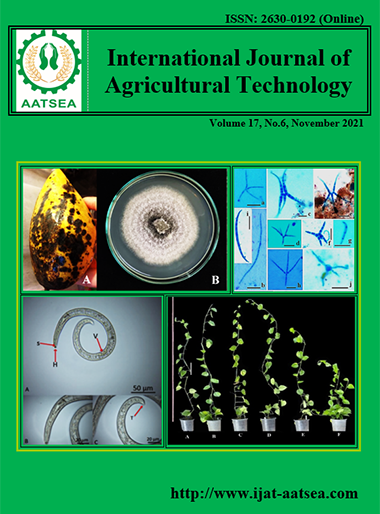Antimicrobial enhancement of Red onion crude extract using Epsilon-polylysine
Main Article Content
Abstract
The antimicrobial activities of red onion extract were investigated by using 50% ethanol solution and combination with epsilon-polylysine against 5 strains of foodborne microorganisms. The Minimum Inhibitory Concentration (MIC) and Minimum Bactericidial Concentration (MBC) were determined using Macrobroth dilution method against selected test organism including Bacillus cereus, Staphylococcus aureus, Listeria monocytogenes, Salmonella Typhimurium and Escherichia coli O157:H7. The MIC of red onion crude extract (ROE) was ranged from 15.00 to 19.00 % (w/v) and the MBC was ranged from 25.00 to 35.00 % (w/v). For epsilon-polylysine (EPL), the MIC was ranged from 0.0150 to 0.0400 % (w/v) and the MBC was ranged from 0.0300 to 0.0650 % (w/v). In addition, the results from the determination of Fractional Inhibitory Concentration Index (FICindex) of the combination between red onion crude extract and epsilon-polylysine using Checkerboard assay against Bacillus cereus, Staphylococcus aureus, Listeria monocytogenes, Salmonella Typhimurium and Escherichia coli O157:H7 were 0.50, 0.50, 0.50, 0.50 and 0.75, respectively. These FICindex values indicated the synergistic activity. The study on the efficacy of the combination system were also determined by Time Killing analysis without interfering substances. The result indicated that the antimicrobial activity of combination system was depended on the concentration of red crude extract and epsilon-polylysine. Therefore, synergistic effect of red crude extract and epsilon-polylysine potentially enhances their antimicrobial activities and may be used as an alternative natural antimicrobial material for food preservative
Article Details

This work is licensed under a Creative Commons Attribution-NonCommercial-NoDerivatives 4.0 International License.
References
Appiah, T., Boakye, Y. D. and Agyare, C. (2017). Antimicrobial Activities and Time-Kill Kinetics of Extracts of Selected Ghanaian Mushrooms. Evidence-Based Complementary and Alternative Medicine. https://doi.org/10.1155/2017/4534350.
Chheda, A. H. and Vernekar, M. (2015). A natural preservative ε-poly-L-lysine: Fermentative production and applications in food industry. International Food Research Journal, 22:23-30.
Elhassaneen, Y. A. and Sanad, M. I. (2009). Phenolics, Selenium, vitamin C, amino acids and pungency levels and antioxidant activities of two Egyptian onion Varieties. American Journal of Food Technology, 4:241-254.
Hyldgaard, M., Mygind, T. B., Vad, S., Stenvang, M., Otzen, D. E. and Meyer, R. L. (2014). The antimicrobial mechanism of action of epsilon-poly-l-lysine. Applied and environmental microbiology, 80:7758-7770.
Hunsinger, B. (2005). Untersuchungen über die Auswirkungen der zukünftigen Eropäischen Desinfektionsmittelprüfung auf die Zulassung von Desinfektionsmitteln für die Tierseuchendesinfektion im Vergleich zu bisherigen Prüfungen nach den Richtlinien der DVG. Dr. Vet. Med. Dissertation, Freien Univertität Berlin, Germany.
Kabrah, A. M., Faidah, D. H., Ashshi, D. A. and Turkistani, M. S. (2016). Antibacterial effect of onion. Scholars Journal of Applied Medical Sciences (SJAMS), 4:4128-4133.
Liu, H., Pei, H., Han, Z., Feng, G. and Li, D. (2015). The antimicrobial effects and synergistic antibacterial mechanism of the combination of ε-Polylysine and nisin against Bacillus subtilis. Food Control, 47:444-450.
Miean, K. H. and Mohamed, S. (2001). Flavonoid (myricetin, quercetin, kaempferol, luteolin, and apigenin) content of edible tropical plants. Journal of Agricultural and Food Chemistry, 49:3106-3112.
Najjar, M. B., Kashtanov, D. and Chikindas, M. L. (2007). ε-Poly-l-lysine and nisin A act synergistically against Gram-positive food-borne pathogens Bacillus cereus and Listeria monocytogenes. Letters in Applied Microbiology, 45:13-18.
Santas, J., Almajano, M. P. and Carbó, R. (2010). Antimicrobial and antioxidant activity of crude onion (Allium cepa L.) extracts. International Journal of Food Science and Technology, 45:403-409.
Shang, D., Liu, Y., Jiang, F., Ji, F., Wang, H. and Han, X. (2019). Synergistic antibacterial activity of designed Trp-containing antibacterial peptides in Combination with antibiotics against multidrug-resistant Staphylococcus epidermidis. Frontiers in Microbiology, 10: https://doi.org/10.3389/fmicb.2019.02719
Sharma, K., Mahato, N. and Lee, Y. R. (2018). Systematic study on active compounds as antibacterial and antibiofilm agent in aging onions. Journal of Food and Drug Analysis, 26:518-528.
Tuersuntuoheti, T., Wang, Z., Wang, Z., Liang, S., Li X. and Zhang, M. (2019). Review of the application of ε‐poly‐L‐lysine in improving food quality and preservation. Journal of Food Processing and Preservation, 43: https://doi.org/10.1111/jfpp.14153.
van Vuuren, S. F., Suliman, S. and Viljoen, A. M. (2009). The antimicrobial activity of four commercial essential oils in combination with conventional antimicrobials. Letters in Applied Microbiology, 48:440-446.
Wang, S., Yao, J., Zhou, B., Yang, J., Chaudry, M. T., Wang, M., Xiao, F., Li, Y. and Yin, W. (2018). Bacteriostatic effect of quercetin as an antibiotic alternative In Vivo and its antibacterial mechanism In Vitro. Journal of Food Protection, 81:68-78.
Ye, C. L., Dai, D. H. and Hu, W. L. (2013a). Antimicrobial and antioxidant activities of the essential oil from onion (Allium cepa L.). Food Control, 30:48-53.
Ye, R., Xu, H., Wan, C., Peng, S., Wang, L., Xu, H., Aguilar, Z. P., Xiong, Y., Zeng, Z. and Wei, H. (2013b). Antibacterial activity and mechanism of action of ε-poly-L-lysine. Biochemical and Biophysical Research Communications, 439:148-153.
Zahi, M. R., Hattab, M. E, Liang, H. and Yuan, Q. (2017). Enhancing the antimicrobial activity of d-limonene nanoemulsion with the inclusion of ε-polylysine. Food Chemistry, 221:18-23.
Zhang, X., Shi, C., Liu, Z., Pan, F., Meng, R., Bu, X., Xing, H., Deng, Y., Guo, N. and Yu, L. (2018). Antibacterial activity and mode of action of ε-polylysine against Escherichia coli O157:H7. Journal of Medical Microbiology, 67:838-845.
Zhilei, T., Shi, Y., Xing, B., Hou, Y. and Jia, S. (2019). The antimicrobial effects and mechanism of ε-poly-lysine against Staphylococcus aureus. Bioresources and Bioprocessing 6. Bioresources and Bioprocessing, 6: https://doi.org/10.1186/s40643-019-0246-8.


